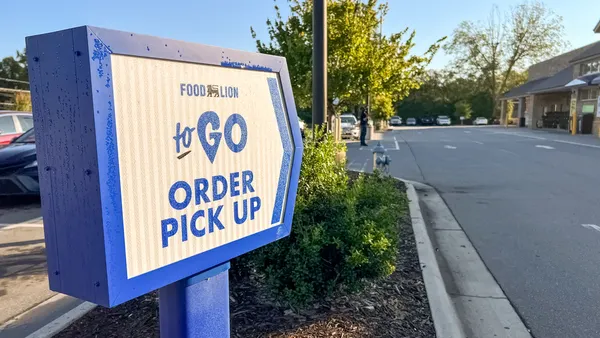Dive Brief:
-
Amazon plans to build more Whole Foods stores, with an eye on suburbs and areas still untouched by the natural grocer, including parts of Idaho, Utah and Wyoming, The Wall Street Journal reported. The grocer has scouted locations up to 45,000 square feet, according to the Journal — larger than most current stores, but extra space will be used for delivery and pickup orders.
-
Amazon plans to expand its Prime Now delivery and store pickup services to most of Whole Foods' 475 U.S. stores, a source told the Journal. Customers in 60 cities can already order delivery through Prime Now, while 30 cities offer pickup within 30 minutes at Whole Foods stores.
-
By focusing on Prime benefits, Amazon hopes to attract new customers to the grocer and provide plenty of incentives to encourage steady traffic. Though sales have jumped at Whole Foods since the $13.5 billion acquisition in 2017, profit continues to fall short of expectations, according to the Journal.
Dive Insight:
Amazon’s stock jumped 1.6% to more than $1,500 a share on Monday after the expansion news broke, Bloomberg reported. In addition to suburbs, Amazon seems to prepping for grocers in all 50 states, as only five (Alaska, Montana, Wyoming, North and South Dakota) have no Whole Foods. Idaho has one store and Utah has four, all in or near Salt Lake City.
It’s also possible that Amazon could expand Whole Foods’ reach in the U.K. and Europe. While Canada has 14 stores, there are only seven across the Atlantic, all in London. Domestically, Whole Foods still has plenty of room to grow if it wants to truly compete in the burgeoning online grocery game. Only 11% of consumers tend to buy groceries online once or twice a month, per a Gallup survey, and they tend to be households with children and higher incomes. Less than 10% of households with incomes under $75,000 use online grocery services, signaling that Amazon has a lot of room to grow in the space.
The Journal story refers to Amazon's “flywheel effect,” a self-perpetuating growth model centered on low prices, low costs and a broad inventory. The e-tailer offers a range of products across its online ecosystem that no other grocer can match, and has moved swiftly to leverage that advantage. Amazon sees itself as uniquely situated to upend the traditional grocery model, as TechSpot reported, and in its first year as Whole Foods parent used its Prime membership to attract new customers.
That strategy has so far proved fairly successful, as a Numerator survey found that half of Whole Foods customers shopped there more often thanks to Prime promotions. (They also bought a record number of turkeys at Whole Foods last Thanksgiving). During the first week of January, for instance, any customer can snag 25% off dietary supplements, vitamins and probiotics, but Prime members receive an additional 10% discount.
But Amazon needs more Whole Foods in more places if it wants to make a true dent in online grocery. It may also need to build more distribution centers — including those dedicated to grocery e-commerce —depending on its growth plans.
Customers already trust Amazon for convenient, fast deliveries of almost anything, and nearly a quarter of respondents to a recent TABS Analytics survey cited the company most often for online grocery. Walmart, the nation’s largest retailer, landed in second place with 15%, while Target and other supermarkets hit 9%.
Kroger also made moves last year, launching direct-to-consumer delivery in four cities in August, with the help of FedEx and USPS, as an add-on to third-party delivery and curbside pickup at more than 1,200 stores. Consumers have expressed interest in subscription services that waive fees for restaurant delivery, a trend that will no doubt play into the development of grocery delivery. Only time will tell if Amazon’s stranglehold on e-commerce and its robust Prime membership base, which surpassed 100 million members last April, can carry it to the top of online grocery, too.












